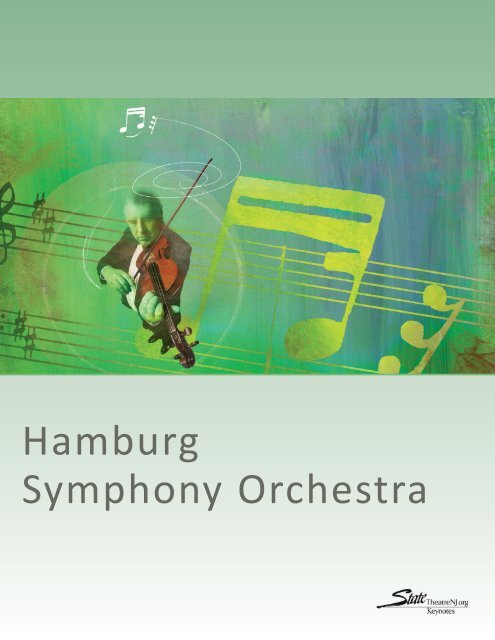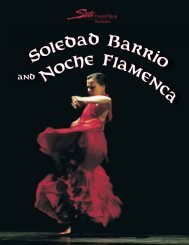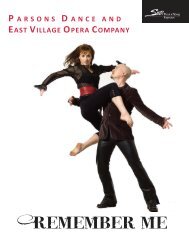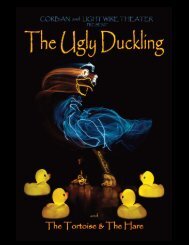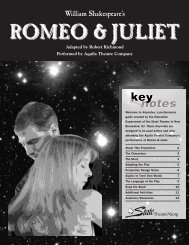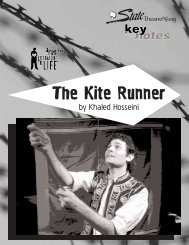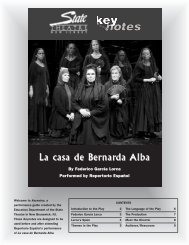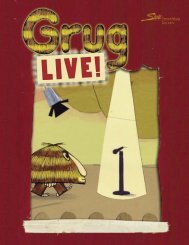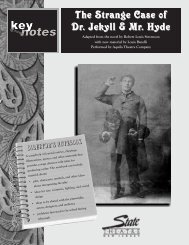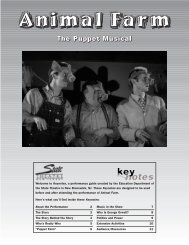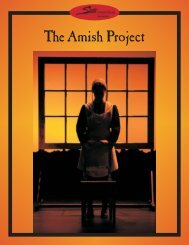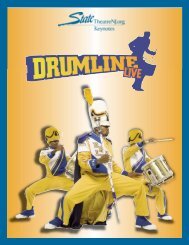Hamburg Symphony Orchestra - State Theatre
Hamburg Symphony Orchestra - State Theatre
Hamburg Symphony Orchestra - State Theatre
You also want an ePaper? Increase the reach of your titles
YUMPU automatically turns print PDFs into web optimized ePapers that Google loves.
<strong>Hamburg</strong><br />
<strong>Symphony</strong> <strong>Orchestra</strong>
Welcome<br />
2<br />
The <strong>State</strong> <strong>Theatre</strong> in New Brunswick, NJ<br />
welcomes you to the performance of the<br />
<strong>Hamburg</strong> <strong>Symphony</strong>.<br />
These Keynotes provide information to help<br />
you take in the performance with a wellinformed<br />
ear and eye. We hope that the guide<br />
will add to your understanding and enjoyment<br />
of the concert and inspire you to continue<br />
exploring the rich world of classical music.<br />
Contents<br />
Welcome ................................................2<br />
Meet the <strong>Orchestra</strong> ............................3<br />
Jeffrey Tate, Conductor ....................4<br />
Guy Braunstein, Soloist ....................5<br />
A Closer Look: The Romantic Era..6<br />
Vaughan Williams................................7<br />
Johannes Brahms ................................8<br />
Meet the Composers ........................9<br />
Antonín Dvořák..................................10<br />
Decoding the Program Page........11<br />
Are You Ready?..................................12<br />
Keynotes are made possible by a<br />
generous grant from Bank of<br />
America Charitable Foundation.<br />
The <strong>State</strong> <strong>Theatre</strong>’s education program is funded in part by Bank of America Charitable Foundation, Colgate-<br />
Palmolive, The Geraldine R. Dodge Foundation, E & G Foundation, Gannett Foundation, The William G. & Helen C.<br />
Hoffman Foundation, The Horizon Foundation for New Jersey, Johnson & Johnson Family of Companies, J. Seward<br />
Johnson, Sr. 1963 Charitable Trust, Karma Foundation, McCrane Foundation, MetLife Foundation, Mid Atlantic Arts<br />
Foundation, National Starch, New England Foundation for the Arts, New Jersey <strong>State</strong> Council on the Arts,<br />
Pennsylvania Performing Arts on Tour, PNC Foundation, Bill & Cathy Powell, The Provident Bank Foundation,<br />
PSE&G, Robert Wood Johnson Foundation, TD Bank, and Wachovia Wells Fargo Foundation. Their support is<br />
gratefully acknowledged.<br />
The <strong>State</strong> <strong>Theatre</strong> <strong>Symphony</strong> Series is made possible through the generous support of<br />
The Blanche and Irving Laurie Foundation.<br />
Funding has been made possible in<br />
part by the New Jersey <strong>State</strong><br />
Council on the Arts/Department of<br />
<strong>State</strong>, a partner agency of the<br />
National Endowment for the Arts.<br />
Continental<br />
Airlines is the<br />
official airline<br />
of the <strong>State</strong><br />
<strong>Theatre</strong>.<br />
The Heldrich<br />
is the official<br />
hotel of the<br />
<strong>State</strong> <strong>Theatre</strong>.<br />
Keynotes are produced by the Education<br />
Department of the <strong>State</strong> <strong>Theatre</strong>,<br />
New Brunswick, NJ.<br />
Mark W. Jones, President & CEO<br />
Lian Farrer, Vice President for Education<br />
Online at www.<strong>State</strong><strong>Theatre</strong>NJ.org/Keynotes<br />
Keynotes for <strong>Hamburg</strong> <strong>Symphony</strong> <strong>Orchestra</strong><br />
written and designed by Lian Farrer and Jennifer<br />
Cunha.<br />
© 2010 <strong>State</strong> <strong>Theatre</strong><br />
Find us at www.<strong>State</strong><strong>Theatre</strong>NJ.org<br />
Contact: education@<strong>State</strong><strong>Theatre</strong>NJ.org<br />
<strong>State</strong> <strong>Theatre</strong>, a premier nonprofit venue for the<br />
performing arts and entertainment.
Meet the <strong>Orchestra</strong><br />
3<br />
Founded in 1957, the <strong>Hamburg</strong> <strong>Symphony</strong> has both a national and<br />
international reputation for being one of the most original symphonies in the<br />
city. As the only orchestra housed in the <strong>Hamburg</strong> Music Hall, they have<br />
secured a key spot in <strong>Hamburg</strong>’s music scene. The orchestra’s first principal<br />
conductor, Robert Heger, has been succeeded by the likes of Imre Kertesz and<br />
Miguel Gómez-Martinez, with guest conductors including Christian<br />
Theilemann, Horst Stein, and Sebastian Weigle.<br />
The <strong>Hamburg</strong> <strong>Symphony</strong>, when not touring, can be heard in subscription<br />
series, including open-air concerts in the summer. One of theses series includes<br />
chamber music concerts, vocal recitals, and concerts devoted to silent films.<br />
The second is a series of concerts for children and young adults, including<br />
outreach programs to schools. In 2008, the orchestra further dedicated itself to<br />
the advancement of young musicians and established an Artist in Residence<br />
position that has featured clarinetist Martin Fröst and violinist Guy Braunstein.<br />
In 2009, Jeffrey Tate took over as Principal Conductor and Daniel Kühnel as<br />
General Manager and Artistic Director. Together, they have strengthened the<br />
orchestra’s connection with the city and increased their audience by 56%. The<br />
<strong>Hamburg</strong> <strong>Symphony</strong> has featured some of the world’s most renowned soloists,<br />
including Frank Peter Zimmerman, Placido Domingo and Elisabeth Leonskaja.<br />
The orchestra has toured throughout Europe in Italy, Spain, Poland, Great<br />
Britain, Turkey, and France, taking it’s place as one of Europe’s foremost<br />
orchestras. This U.S. tour marks the first time the symphony as visited the <strong>State</strong>s<br />
since 2007.<br />
“From the warmth of the first<br />
horn chords and the airy<br />
lightness of the violins in the<br />
first movement, to the<br />
grandeur of the finale, the<br />
<strong>Hamburg</strong>’s performance was<br />
all one hoped for. There were<br />
moments when sections or<br />
individuals shone... when the<br />
orchestra itself seemed to<br />
dance."<br />
—Newsday
Jeffrey Tate, Conductor<br />
4<br />
British conductor Jeffrey Tate is one of the most<br />
renowned conductors of his generation. His current home is<br />
with the <strong>Hamburg</strong> <strong>Symphony</strong> <strong>Orchestra</strong> as Principal Conductor<br />
in Germany, but he has performed with nearly every major<br />
orchestra in the world.<br />
Music was not Maestro Tate’s first profession. He<br />
originally studied medicine at the University of Cambridge and<br />
was an eye surgeon in London for three years before joining<br />
the music staff at the Royal Opera Covent Garden in 1970. Tate<br />
made his conducting debut at Gothenburg Opera in 1978.<br />
Since then, he has become famous as a conductor of the music<br />
of Wagner and<br />
Strauss, along with music of the romantic and classical repertoires, 19th and<br />
“As the music moved under<br />
20th century British music, and contemporary music. In the 1982-83 season<br />
my hands, I suddenly felt<br />
alone, Tate conducted at the Royal Opera House, the Met in New York City,<br />
that I was doing something I<br />
and with the English Chamber <strong>Orchestra</strong>, eventually being appointed<br />
Principal Conductor in 1985.<br />
had been waiting to do all my<br />
Maestro Tate has conducted world premiere performances of Henze’s Il life.”<br />
Ritorno d’Ulisse at the Salzburg Festival and of Rolf Liebermann’s Der Wald<br />
— Jeffrey Tate<br />
in Geneva. Over the years, Tate has been appointed Music Director of the<br />
Rotterdam Philharmonic <strong>Orchestra</strong>, Principal Guest Conductor of the<br />
Orchestre National de France, and the Royal Opera House Covent Garden. He has also conducted performances at the<br />
Bastille Opera and the Châtelet in Paris, not to mention Palais Garnier and La Scala Milan. He has developed relationships<br />
with orchestras throughout the world, often returning to perform with them. These include the Berlin Philharmonic,<br />
Dresden Philharmonic, the Boston <strong>Symphony</strong>, Maggio Musicale Fiorentino, and Sydney <strong>Symphony</strong>, to name a few.<br />
In 2001, Maestor Tate was named the Honorary Director of the National Italian Radio <strong>Orchestra</strong>. For the 2009-10<br />
season, he was nominated to become Chief Conductor of the <strong>Hamburg</strong> <strong>Symphony</strong> <strong>Orchestra</strong>. Already thinking ahead,<br />
Jeffrey Tate is scheduled to work on Billy Budd at the Bastille in Paris and also to do two complete cycles of Richard<br />
Wagner’s Ring des Nibelungen during the 2013-14 season at Vienna <strong>State</strong> Opera.<br />
After more than four decades as a prominent conductor, there is no doubt that Maestro Tate has garnered many<br />
awards in his career. In 2001, 2002, and 2010, he was awarded the Franco Abbiati Prize, which is Italy’s most prestigious<br />
prize, for his work with <strong>Orchestra</strong> Sinfonica Nazionale della RAI, Teatro San Carlo in Napoli, and for the production of<br />
Götterdämmerung at La Fenice in Venice. Tate has also earned the titles of “Chevalier de la Légion d’Honneur,” “Chevalier<br />
des Arts et des Lettres,” and Commander of the British Empire for his work.
Guy Braunstein, Soloist<br />
5<br />
Violinist Guy Braunstein was born in Tel Aviv, Israel.<br />
There, he studied the violin with Chaim Taub. When he<br />
came to New York, he then learned under Glenn Dicterow<br />
and Pinchas Zuckerman. His career as a soloist began at a<br />
young age and has continued to grow ever since. Through<br />
the years, he has played with the Isreal Philharmonic,<br />
Bamberg <strong>Symphony</strong>, Tonhalle Zurich, and Berliner<br />
Philharmoniker, to name a few.<br />
Over his prestigous career, Braunstein has collaborated<br />
with the likes of Issac Stern, Daniel Barenboim, Sir Simon<br />
Rattler, Jonathan Nott, Gary Bertini, and Angelika<br />
Kirschlager. In 2000, he was the youngest person in the<br />
history of the Berliner Philharmonker to be appointed<br />
concertmaster. He has kept his position and works with<br />
them for approximately four months per year.<br />
From 2003 to 2007, Braunstein served as Professor of<br />
Music in the University of the Arts (Universitaet der Kunst)<br />
in Berlin. Germany’s Rolandseck festival has had<br />
international stars including Emmanuel Pahud, Amihai Grosz, and<br />
François Leleux since Guy Braunstein took over as Music Director<br />
in 2006.<br />
During the 2010-11 season, Braunstein performed with Sofia<br />
Philharmonic <strong>Orchestra</strong> and Mozarteun <strong>Orchestra</strong> Salzburg. He<br />
also play-directed the Halle Staatskapelle and performed recitals<br />
and chamber music concerts throughout Europe, making stops in<br />
London, Jerusalem, Berlin, and Frankfurt. Guy is also a member of<br />
the West-Eastern Divan <strong>Orchestra</strong>.<br />
Guy Braunstein’s repertoire is quite impressive, covering 19<br />
composers and 30 pieces. He covers Bach, Beethoven, Haydn,<br />
Mozart, and Vivaldi and does so with a rare violin made in 1679 by<br />
Francesco Ruggieri.<br />
Ruggieri’s Violin<br />
Francesco Ruggieri (1620-<br />
1695) is the first in a family<br />
of violin crafters out of<br />
Cremona, located in northern<br />
Italy on the left bank of the<br />
Po River. Often thought of as<br />
the first pupil of famous<br />
violin maker, Nicolo<br />
Amati, Ruggieri<br />
patterned his<br />
instruments on Amati’s<br />
designs. Ruggieri’s<br />
instruments are known<br />
for their rich, full tone<br />
and beautiful<br />
craftsmanship, although<br />
he is more known for his cellos.
A Closer Look :<br />
The<br />
Romanc Era<br />
6<br />
JMW Turner, “Chichester Canal” (1828)<br />
ROMANTIC<br />
1. displaying or expressing love or<br />
strong affection.<br />
2. ardent; passionate; fervent.<br />
3. imbued with or dominated by<br />
idealism, a desire for adventure,<br />
chivalry, etc.<br />
4. (usually initial capital letter)<br />
pertaining to or characteristic of<br />
a style of literature and art that<br />
subordinates form to content,<br />
encourages freedom of<br />
treatment, emphasizes<br />
imagination, emotion, and<br />
introspection, and often<br />
celebrates nature, the ordinary<br />
person, and freedom of the spirit<br />
(contrasted with classical).<br />
5. of or pertaining to a musical<br />
style characteristic chiefly of the<br />
19th century and marked by the<br />
free expression of imagination<br />
and emotion, virtuosic display,<br />
experimentation with form, and<br />
the adventurous development of<br />
orchestral and piano music and<br />
opera.<br />
6. fanciful; impractical; unrealistic.<br />
7. imaginary, fictitious, or<br />
fabulous.<br />
Johanne Brahms’, whose work you will hear at the concert is a product of<br />
music’s Romantic Era (roughly 1800-1910). The Romantic movement<br />
encompassed not only music, but architecture, visual art, literature, dance,<br />
theater, and philosophy as well.<br />
The roots of Romanticism in music were in the preceding Classical Era, where<br />
18th-century composers such as Mozart and Haydn perfected the musical<br />
expression of the Age of Reason. Their works emphasized clarity and proportion<br />
in both structural and harmonic language. In their orchestral works (as opposed<br />
to their operas), the music stood on its<br />
own, unconnected to ideas, images, drama, “People often complain that<br />
or other non-musical elements.<br />
music is ambiguous, that their<br />
During the Romantic Era, music moved ideas on the subject always seem<br />
from the abstract into the realm of the so vague, whereas everyone<br />
representational. Now it might tell a story, understands words. With me it is<br />
conjure an image, stir emotions. The genre exactly the reverse—not merely<br />
became known as “program music”—<br />
with regard to entire sentences,<br />
music that has an underlying narrative or<br />
but also as to individual words.<br />
non-musical meaning. The emotional<br />
These, too, seem to me so<br />
content was typically intense. This was the<br />
ambiguous, so vague, so<br />
era that gave us the operatic mad scene,<br />
unintelligible when compared<br />
the symphonic shipwreck, and the<br />
with genuine music, which fills<br />
revolutionary étude. Besides love, popular<br />
subjects in Romantic music included<br />
the soul with a thousand things<br />
nature, introspection, imagination, and the better than words.”<br />
supernatural. Political revolutions in Europe —composer Felix Mendelssohn<br />
during the 19th century created a wave of<br />
nationalism that was reflected in the music of the Romantic Era. Composers<br />
proudly integrated traditional music of their homeland into their works.<br />
Looking for a broader palette with which to paint their musical pictures,<br />
Romantic composers loosened and expanded the formal conventions of the<br />
Classical Period, as applied to form, melody, harmony, tonal relationships, and<br />
instrumentation. They still wrote symphonies, concertos, sonatas, and the like,<br />
but they also created symphonic poems, program symphonies, fantasies,<br />
nocturnes, impromptus, mazurkas, song cycles and other new genres that<br />
expressed their aesthetic ideas.
Vaughan Williams:<br />
7<br />
The Wasps Overture<br />
Wasps are not loveable insects. In the summer and fall, they<br />
swarm around visitors at street cafes, landing on whatever is<br />
sweet on the table and often enough in drinks. It is impossible to<br />
get rid of them without attracting even more of the creatures.<br />
This appears to have been the case in antique times as well, for<br />
the Greek dramatist Aristophanes, in his comedy The Wasps from<br />
422 BC, used wasps as a metaphor for litigious citizens who took<br />
every opportunity to engage in legal battles. The historical<br />
background for this was an increase in the remuneration for<br />
citizens who served as trial judges. In ancient Athens, with its<br />
specific early form of democracy, being a judge was not an<br />
institutionalized profession, but rather one of the responsibilities<br />
required of full citizens. Following the laws of the city, judges<br />
arrived at their decisions after both parties in a case – the accuser<br />
and defendant or their representatives – had presented their<br />
positions. For this, the judge received a kind of expense<br />
allowance, which was increased by a third under the rule of Cleon.<br />
As a result, the willingness of the Athenians to go to court grew<br />
dramatically, which Aristophanes used as the point of departure<br />
for his comedy. He dealt with this situation in a highly satirical<br />
manner by making the chorus of amateur judges into wasps and<br />
the stylus with which the decision was written a wasp’s stinger.<br />
Ralph Vaughan Williams composed his incidental music in<br />
1909 for a performance of The Wasps at Trinity College in<br />
Cambridge. He wrote not only the usual overture and interludes<br />
between scenes, but also set a number of complete scenes to<br />
music, so that the entire incidental music for the play lasts almost<br />
two hours. The music is rarely performed in its entirety, but<br />
Vaughan Williams himself arranged a suite consisting of five<br />
instrumental pieces. The suite begins with an overture that is in<br />
itself a splendid concert piece. The wasps can be heard<br />
immediately; the instruments as they enter conjure up a swarm of<br />
insects that buzz aggressively around the ears of the listeners.<br />
This introduction is followed by the spirited presentation of three<br />
themes sung by the chorus in the course of the play. This lively<br />
music exudes energy and high spirits. It was particularly<br />
important to Jeffrey Tate to bring music by an English composer<br />
to audiences on the <strong>Hamburg</strong> <strong>Symphony</strong> <strong>Orchestra</strong>’s American<br />
tour. Vaughan Williams’s setting of music for the ancient comedy<br />
is modern and delightful, full of striking instrumental effects<br />
without literally invoking antique musical conventions.<br />
© 1994 Columbia Artists Management Inc.<br />
Ralph<br />
Vaughan<br />
Williams<br />
was born in<br />
1872 in the<br />
Cotswold<br />
village of<br />
Down<br />
Ampney. He attended the Charterhouse School<br />
followed by Trinity College in Cambridge. Later he<br />
was trained by Hubert Parry and Charles Stanford at<br />
the Royal College of Music.<br />
Until he was 32-years-old Vaughan Williams<br />
showed no desire to be anything other than an<br />
industrious and efficient church musician. Fortunately<br />
after a few years at his first professional post as<br />
organist at the St. Barnabas Church in London he was<br />
introduced to English folk music and his former<br />
interest in church music was overtaken by his passion<br />
for folk songs. This gave Vaughan Williams the<br />
materials he needed to build new musical works.<br />
Between 1905 and 1907 he wrote three Norfolk<br />
rhapsodies for orchestra and produced a major<br />
choral work, “Toward the Unknown Region” in the<br />
English style, however inspired by American poet<br />
Walt Whitman. He completed his first important<br />
piece of work just two years later—Fantasia on a<br />
Theme by Thomas Tallis.<br />
After the war he joined the faculty of the Royal<br />
College of Music teaching composition. He also<br />
became the conductor of the Bach Choir in London<br />
from 1920-1926. Premieres of his works became<br />
events of national significance. In the decade<br />
following World War I he composed numerous<br />
masterpieces still heard today. In 1935 he received<br />
one of the highest awards a composer can receive –<br />
the Order of Merit. He died on August 26, 1958.
Johannes Brahms:<br />
8<br />
Violin Concerto in D Major, Op. 77<br />
In 1853, Brahms embarked on a concert tour with the Hungarian violinist Eduard Hoffmann (a.k.a. Reményi). It was during<br />
their stop at Göttinger, near Hanover, that Brahms came to meet Joseph Joachim, the virtuoso violinist – also a composer –<br />
with whom he established an immediate rapport, flourishing into their long friendship. Joachim proved to be enormously<br />
influential in Brahms’ career, as well as in the younger man’s development as a composer. The two shared an identity of<br />
artistic outlook, and a great admiration for each other’s works; together they stood firmly against the “New German School”<br />
as exemplified by Liszt and, later, Wagner. It was at Joachim’s suggestion that Brahms met Robert Schumann and his wife<br />
Clara, both of whom were to become important in his life as well as in his further development as a composer.<br />
Equally important, as a conductor Joachim introduced several of Brahms’ orchestral works, thus garnering recognition for<br />
the younger composer and establishing his reputation, especially in England where the virtuoso/conductor was regarded with<br />
high esteem. Early on, Brahms benefited immensely from Joachim’s advice regarding orchestration, and from hearing<br />
Joachim’s Hanover Quartet perform some of his chamber works. It was not surprising, then, that when Brahms wrote his<br />
masterful Violin Concerto in 1878, he would ask his friend for technical advice regarding the solo part: “I will be satisfied if<br />
you will let me have a few words, and perhaps even write some in the score: difficult, uncomfortable, impossible, etc.”<br />
Joachim—for whom the work was composed and to whom it is dedicated—assured Brahms that “…most of the material is<br />
playable, but I wouldn’t care to say whether it can be comfortably played in an overheated concert hall until I have played it<br />
through to myself without stopping.” Indeed, the violinist provided some invaluable guidance in the form of fingerings and<br />
bowings, but ultimately, Brahms adhered to his original ideas. Joachim did also write the cadenza for the first movement,<br />
although, many other violinists have provided their own cadenzas since then.<br />
Joachim introduced Brahms’ Violin Concerto on New Years Day, 1879, at the Leipzig Gewandhaus, with the composer at<br />
the podium. The premiere of the work was not entirely well received, and the infamous critic Hans von Bülow called it “clumsy<br />
and devoid of flexibility,” further describing the work as being “written not for but against the violin.” However, through the<br />
dedicated advocacy of Joachim, the concerto soon gained its deserved recognition and a very secure place in the repertoire.<br />
A later advocate of the work, Bronislaw Huberman would answer Bülow’s criticism with the words: “Brahms’ concerto is<br />
neither against the violin nor for violin with orchestra but…for violin against orchestra – and the violin wins.”<br />
The main theme of the first movement (Allegro non troppo) is announced by violas, cellos, bassoons and horns. This<br />
subject, and three contrasting song-like themes, together with an energetic dotted figure, marcato, furnish the thematic<br />
material of the movement. The solo violin is introduced, after almost a hundred measures for the orchestra alone, in an<br />
extended section, chiefly of passagework, as a preamble to the exposition of the chief theme. With great skill, Brahms<br />
unleashes his two essentially unequal forces: the tender, lyric violin and the robust orchestra. In the expansive and emotional<br />
development, the caressing and delicate weaving of the solo instrument about the melodic outlines of the song themes in<br />
the orchestra is most unforgettable. A particular high point is provided when the long solo cadenza merges with the serene<br />
return of the main theme in the coda that concludes the movement.<br />
This feature is even more pronounced in the second movement (Adagio), where a dreamy oboe introduces the main<br />
theme against the background provided by the rest of the woodwinds. The solo violin, makes its compliments to the main<br />
theme, and announces an ornamental second theme. Adding the warmth of its tone, the soloist proceeds to embroider its<br />
arabesques and filigrees upon the thematic material with captivating and tender beauty.<br />
The Finale (Allegro giocoso, ma non troppo vivace) is a virtuoso’s tour de force, built upon a compact rondo structure,<br />
containing three distinct themes. The jovial main theme, in thirds, is stated at once by the solo violin. The thematic material<br />
and its eventual elaboration provide many hazards for the soloist: precarious passagework, double-stopping and arpeggiated<br />
figurations. But the music, inhabiting the carefree world of Hungarian gypsies, is quite spirited and fascinating—music of<br />
incisive rhythmic charm and great zest, which in turn pays tribute to the composer’s friend and colleague, Joachim. After the<br />
proceedings accelerate to a quick march tempo based on the main theme, the brilliant coda finally slows down to bring the<br />
concerto to its elegant conclusion.<br />
© 1994 Columbia Artists Management Inc.
Meet the Composers<br />
9<br />
Born in 1833 in <strong>Hamburg</strong>, Germany, composer and pianist Johannes Brahms<br />
was the son of a double-bass player, who gave him his first musical training. The<br />
young Brahms gave a few public concerts in <strong>Hamburg</strong>, but did not become well<br />
known as a pianist until he made a concert tour at the age of 19. In later life, he<br />
frequently took part in the performance of his own works, whether as soloist,<br />
accompanist, conductor, or participant in chamber music.<br />
Brahms spent most of his professional life in Vienna—a major music capital—<br />
where some looked to him as the successor to Beethoven. Like Beethoven, Brahms<br />
was both a traditionalist and an innovator. His music is grounded on the structures<br />
and compositional techniques of the Baroque and Classical masters. Though he<br />
employed familiar structural underpinnings, Brahms created a bold new harmonic<br />
language that was anything but traditional, challenging the existing conventions of<br />
tonal music. With a point of view that looked both backward and forward,<br />
Brahms came to be an important influenced for both conservative and<br />
modernist composers who followed him.<br />
Brahms resembled Beethoven temperamentally, as well as musically. Both<br />
enjoyed nature, and both had a reputation for gruffness, especially with<br />
adults. Still, Brahms had a number of strong friendships with other<br />
musicians: composer Robert Schumann and his wife, the pianist Clara Schumann;<br />
violinist Joseph Joachim; and “waltz king” Johann Strauss II. Though he never married,<br />
he is thought to have carried a lifelong—though unrequited—passion for Clara Schumann.<br />
Check out the Johannes Brahms WebSource<br />
at: www.johannesbrahms.org<br />
and the American Brahms Society at<br />
http://brahms.unh.edu/<br />
Composer Antonín Dvořák (1841-1904) wrote in a variety of classical<br />
forms, including symphonies, concertos, ‘symphonic poems,’ chamber music,<br />
choral and piano music, and even opera. His music is characterized by a fusion<br />
of European Romantic style with the idioms and melodies of the folk music of<br />
the composer’s native Bohemia.<br />
Dvořák was the son of a butcher (who also worked as a professional zither<br />
player). Displaying talent at an early age, the boy took lessons in organ, viola,<br />
piano and basic composition. After graduating from the Prague Organ School,<br />
he became a member of the new Provisional <strong>Theatre</strong> orchestra, which was conducted by the Czech nationalist composer<br />
Bedrich Smetana.<br />
Eventually Dvořák left the orchestra to devote himself full time to composing. By his early 30s, he was sufficiently well<br />
known for Johannes Brahms to recommend him to the music publisher Simrock; the company commissioned Dvořák’s hugely<br />
successful Slavonic Dances (1878). His music was increasingly performed to great acclaim, leading to new commissions and<br />
invitations to tour abroad. England was especially hospitable to the composer, hosting frequent visits, commissioning new<br />
works, and even awarding him an honorary Cambridge doctorate. He visited Russia in 1890, continued to launch new works<br />
in Prague and London and began teaching at the Prague Conservatory in 1891.<br />
Dvořák’s fame was not limited to Europe. From 1892-1895 he served as director of the National Conservatory in New York<br />
City, where he also taught composition. In New York he wrote his best-known work—the Ninth <strong>Symphony</strong> (“From the New<br />
World”), as well as the Cello Concerto in B minor. The composer’s American sojourn included a summer in the Czechspeaking<br />
community of Spillville, Iowa, where he wrote two of his most beloved chamber works: the String Quartet in F (“The<br />
American”), the String Quintet in E-flat.<br />
Financial disputes and family ties took him back home, where he focused on writing opera and chamber music. He served<br />
as director of the Conservatory in Prague from 1901 until his death in 1904.
Antonín Dvořák:<br />
10<br />
<strong>Symphony</strong> No. 7 in D minor,<br />
Op. 70, B. 141<br />
Antonín Dvořák<br />
Born September 8, 1841 in Nelahozeves<br />
Died May 1 , 1904 in Prague<br />
Dvořák’s <strong>Symphony</strong> No. 7 was accepted immediately by conservatives and progressives alike. By that time, the composer<br />
had already achieved success both at home and abroad. On March 13, 1884 he conducted his Stabat Mater, followed by a<br />
concert of his orchestral works in London. The triumph of these performances led to many new invitations to England. He<br />
was showered with orders from home and abroad, including the supreme honor of membership to the London Philharmonic<br />
Society, accompanied by their request that he compose a new symphony for them.<br />
The rugged style of this symphony can be compared with that of Dvořák’s supporter, Johannes Brahms, who at that time<br />
was renowned as a writer of symphonies. It is possible that through this work Dvořák wanted to become an artistic rival; in<br />
fact, the <strong>Symphony</strong> No. 7 is noticeably like Brahms in character. It should be added, however, that this work has an even<br />
greater similarity of style to Dvořák’s own “Little” <strong>Symphony</strong> No. 4 in D minor, which he wrote before Brahms had composed<br />
his first symphony.<br />
The Seventh <strong>Symphony</strong> was published in Berlin in 1885 and received its premiere performance in London’s St. James Hall<br />
on April 22, 1885, with the London Philharmonic and composer as conductor. It is interesting to note that after the<br />
performance, Dvořák deleted approximately forty measures from the second movement “in order that the work should not<br />
contain a single unnecessary note.” The German conductors who zealously performed the symphony were Hans von Bülow,<br />
Hans Richter and Arthur Nikisch; the latter also conducted it on his American tour.<br />
The first movement, Allegro maestoso, is in the key of D minor. The opening theme is given to the violas and cellos, which<br />
is taken up and varied slightly by the clarinets. The second theme, of an energetic character, follows and is derived from the<br />
Allegro of the Hussite Overture. It is presented by the strings and reaches a climax as the first theme’s restatement begins.<br />
The vigorous development section precedes a compressed recapitulation; unusual in that it begins in an unorthodox key but<br />
returns to the tonic by the time its conclusion is reached. The movement ends with an extended, somewhat tense, coda.<br />
The second movement, Poco adagio, in the relative major key of F major, introduces one of Dvořák’s more inspired<br />
melodies. This is followed by a theme, presented by the horns and clarinet, reminiscent of Tristan und Isolde. After a<br />
passionate dialogue, the movement returns to the principle theme, begun from its middle, providing a most unusual, but<br />
effective device.<br />
The third movement, a Scherzo in vivace tempo in the key of the symphony’s minor tonic and cast in duple time, achieves<br />
some rather piquant rhythmic effects through the use of syncopation. The two themes alternate between various choirs of the<br />
orchestra and maintain the lively, dance-like character of the movement. The Trio section provides contrast to the Scherzo<br />
section not only in its tempo, marked Poco meno mosso, but also in its key of G major and its use of an imitative motif. The<br />
return of the Scherzo is slightly telescoped but has the addition of a charming cadential theme at the close.<br />
The Finale: Allegro, in the key of D minor and in duple time, is rich in thematic material. A march-like theme is the principle<br />
motive and this is presented in numerous guises, alternating with new material. The development section presents the<br />
themes already heard in creative combinations demonstrating a remarkable resourcefulness on Dvořák’s part. A rapid<br />
crescendo brings the movement to its recapitulation. Dvořák, utilizing ten majestic concluding chords in D major, brings the<br />
work to a triumphant resolution.<br />
© 1999 Columbia Artists Management Inc.
Decoding the Program Page<br />
11<br />
The program book (or playbill) contains helpful information about the performance. It lists the pieces the orchestra will play<br />
in the order they will play them. It tells you the name of each piece, the name of the composer, and the movement headings.<br />
If you’re not familiar with a piece, the program will help you keep track of what’s going on and know when the piece is<br />
finished. The program page for the Philharmonic of Poland looks like this:<br />
A MOVEMENT is a section<br />
within a musical piece, like a<br />
chapter in a book. Individual<br />
movements are usually<br />
referred to by the tempo<br />
marking that the composer<br />
has written at the beginning<br />
of the section. During the<br />
concert, there is usually a<br />
brief pause between<br />
movements, during which the<br />
audience should remain silent.<br />
Today’s concert etiquette<br />
dictates that you hold your<br />
applause until the entire piece<br />
is finished.<br />
OPUS NUMBER<br />
(among all of Brahms’<br />
published works)<br />
There are several ways that<br />
works of classical music can<br />
be identified. The system is<br />
not consistent from one<br />
composer to another.<br />
COMPOSER<br />
SOLOIST<br />
• NUMBER - where the piece<br />
falls in the catalogue of the<br />
composer’s works for a<br />
specific musical form (such<br />
as the Ninth <strong>Symphony</strong> or<br />
the Bassoon Concerto No.<br />
2).<br />
• OPUS NUMBER - where<br />
the piece falls in the entire<br />
catalogue of the composer’s<br />
works, in the order they<br />
were published. The lower<br />
the number, the earlier it<br />
was published (but not<br />
necessarily when it was<br />
written). Opus is a Latin<br />
word meaning “work.”<br />
FUNDING CREDITS<br />
Many arts institutions<br />
(including the <strong>State</strong><br />
<strong>Theatre</strong>) are not-for-profit<br />
organizations;<br />
acknowledging donors<br />
and sponsors is an<br />
important part of staying<br />
in business.<br />
what KEY the<br />
music starts in
Are You Ready?<br />
12<br />
To Clap, or Not to Clap...<br />
People who’ve never attended an orchestra concert are<br />
sometimes apprehensive about applauding at the wrong<br />
time. If you’re one of those people, here are some general<br />
rules to guide you:<br />
• Just before the concert begins, the audience will applaud<br />
the arrival onstage of the concertmaster (the first violinist,<br />
who acts as the leader of the musicians). They’ll applaud<br />
again when the conductor and soloist(s) enter.<br />
• If they’ve liked the performance, the audience will<br />
applaud at the end of each piece of music on the<br />
program. Applauding between the movements or sections<br />
of a piece is generally frowned upon, even if there’s a<br />
long pause. Many people believe that applauding<br />
between movements breaks the spell or momentum of<br />
the piece. If you’re not sure when a piece is finished,<br />
check the program to see how many movements there<br />
are, or applaud only when the conductor turns to the<br />
audience and bows.<br />
Some Additional Tips on<br />
Concert Etiquette<br />
• All it takes is one ringing cell phone, noisy latecomer, or<br />
loudly whispered conversation to spoil a concert for the<br />
entire audience. Be sure to arrive on time and turn off<br />
phones, pagers, beepers, and other electronic devices<br />
before the performance begins. Hold your comments and<br />
conversation until intermission.<br />
• Even if you’re not making or receiving calls, those little<br />
squares of light are a distraction to anyone sitting near<br />
you; please refrain from texting, checking messages, etc.<br />
during the concert.<br />
• Though concertgoers are doing it more and more these<br />
days, it’s generally considered impolite to leave the hall<br />
while the audience is still applauding. And if you leave too<br />
soon, you’ll miss the encore, if the orchestra plays one!<br />
• When a piece has ended, the conductor (and soloist, if<br />
there is one) may leave the stage and then return for<br />
curtain calls, depending on the level of applause.


